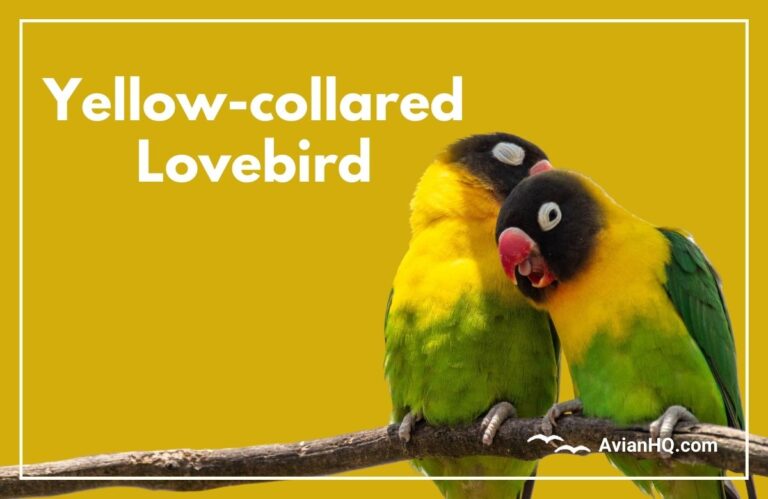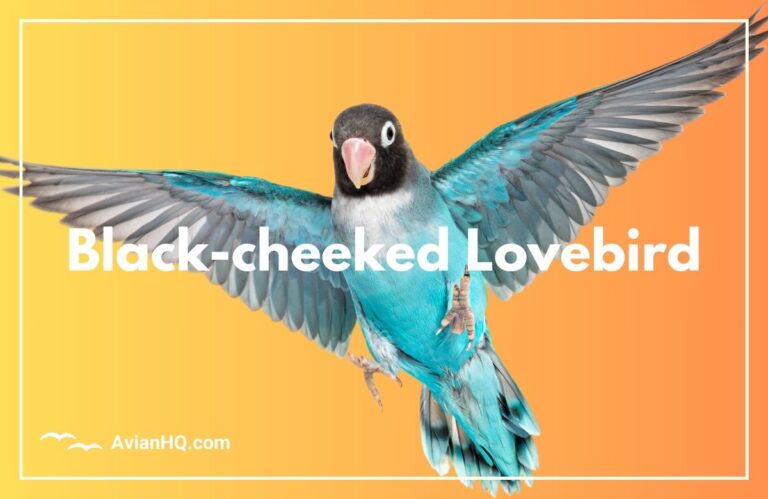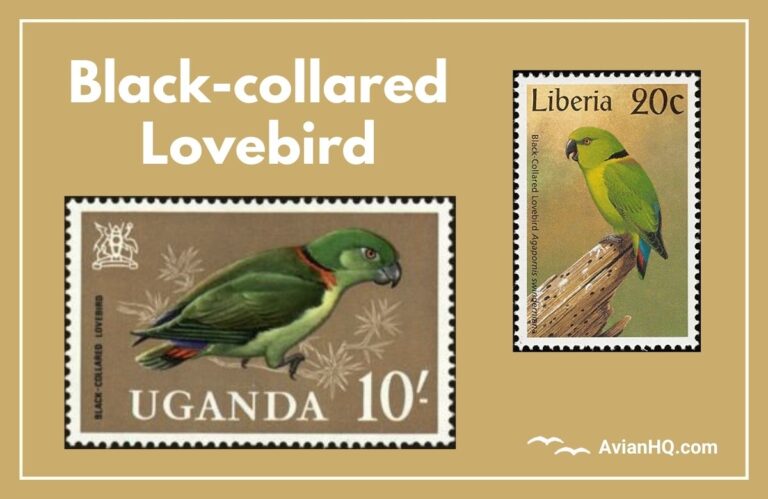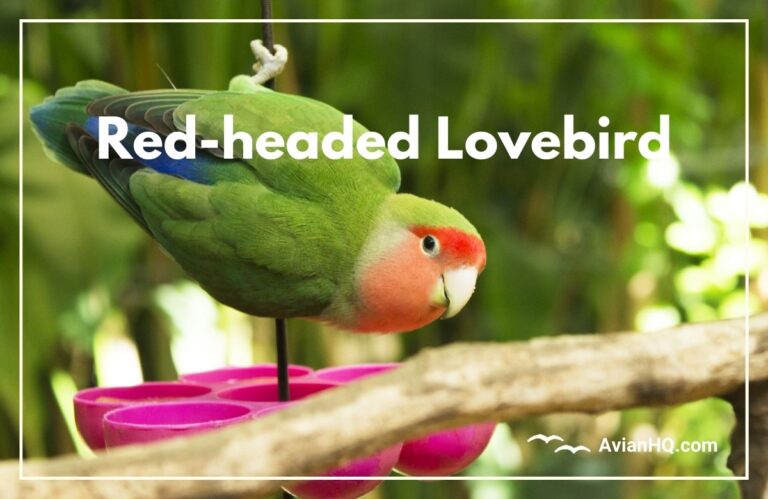Fischer’s Lovebird (Agapornis fischeri)
Have you ever seen a small, colorful parrot with a bright red beak and wondered what kind of bird it was? Chances are it was a Fischer’s Lovebird, one of the most popular pet bird species. Known for their charming personalities and bright green plumage accented with vibrant red and yellow, Fischer’s Lovebirds make delightful companions.
In the wild, these little parrots live in small flocks among arid grasslands and agricultural areas in central Africa. Weighing only 1.5-2 ounces (43-58 grams) and reaching lengths of just 5.5 inches (14 cm), they are one of the smaller members of the lovebird genus Agapornis. Still, what Fischer’s Lovebirds lack in size they make up for in volume with their constantly chattering voices.
If you’re curious to learn more about these feisty and vocal little parrots both in their native habitat and in captive care, read on. We’ll cover everything from their natural history and conservation status to what its like to have a Fischer’s Lovebird perched on your shoulder. You’ll also learn fun facts about their appearance, breeding behaviors, typical diets, and the intricacies of their strong pair bonds.
So let’s dive in and explore why so many bird enthusiasts adore the Fischer’s Lovebird! Their emerald green plumage accented in vibrant reds and yellows makes them visually stunning. But its their big personalities packed into a petite body that will make you fall in love with Agapornis fischeri.
History and Taxonomy
The vibrant Fischer’s Lovebird was first discovered by Europeans in the late 19th century on an expedition to Tanzania led by German explorer Gustav Fischer. He first documented the small green parrots with red beaks in 1884, and the species was later named Agapornis fischeri in his honor.
The name “lovebird” stems from the strong pair bonds these little parrots form. Fischer’s Lovebirds choose a mate and remain faithfully monogamous for life. When separated, the mates even display signs of grief and their health declines. Its this charming attachment to their partners that earned the genus Agapornis the romantic moniker of “lovebird.”
There is only one recognized subspecies of the Fischer’s Lovebird: the nominate race A. fischeri fischeri. This naming means it is the “original” variant that defines the species characteristics. Within aviculture, however, there are several color mutations of A. fischeri that have been selectively bred.
The most popular mutation is the blue Fischer’s Lovebird. These vivid azure colored birds lack the yellow hues and instead display bright blue back, chest, and tail feathers. Other color variants include lutinos (pale yellow with orange face), albinos, black/dark eyed whites, and pieds. Still, the verdant green wild-type Fischer’s Lovebird remains the most familiar and preferred type among bird owners.
Physical Appearance
In the wild, adult Fischer’s Lovebirds display a primarily green coloration to their bodies, wings and tails. Their most striking markings are a golden yellow neck and breast that graduates into a vivid orange facial mask around their eyes and beak. The upper surface of their tails have some iridescent royal blue feathers mixed among the green.
Their short tails and wings enable their remarkably speedy and agile flight skills through the African skies. Other distinguishing features are the white circle of feathers surrounding their eyes called the eye-ring, and their bright crimson colored beaks.
Fischer’s Lovebird’s have an overall body length of 5.5 inches (14 cm) from head to the tip of their tail. Their petite frames weigh just 1.5-2 ounces (43-58 grams) on average.
There is very little difference in physical appearance between male and female adult Fischer’s Lovebirds, a phenomenon called sexual monomorphism. Because the sexes appear identical, DNA testing is required to determine gender. Females may display some subtle hints though, like sitting with their legs slightly farther apart.
Juvenile lovebirds have a mostly green plumage similar to the adults, but their colors are duller overall. Younglings also have some little brown speckles at the base of their beaks that disappear as they mature.
While Fischer’s living in American and European homes still display the wild olive green hues, selective breeding has produced some gorgeous color variations. The most popular mutation is the true blue Fischer’s, with their deep azure feathers. But you may also spot gorgeous yellow lutinos, albino, black/white, and even adorable piebald Fischer’s Lovebirds with their patchwork patterns.
Habitat and Distribution
In the wild, Fischer’s Lovebirds inhabit a small region of central Africa, just south and southeast of Lake Victoria in northern Tanzania. This area sits at elevations between 1,100-2,200 meters (3,600-7,200 ft) above sea level.
Their native environment is semi-arid grassland dotted with small copses of trees. They tend to forage and nest near water sources, flitting between isolated clumps of vegetation in the otherwise open plains.
Fischer’s Lovebird populations are endemic to Tanzania, though some do make temporary migrations into neighboring Rwanda and Burundi during drought years in search of sustenance. Unfortunately the vibrant little parrots have also been introduced to areas outside their native range through the exotic pet trade.
Small feral breeding colonies of Fischer’s Lovebirds have been spotted around coastal regions of Tanzania, as well as in Kenya, Puerto Rico, the U.S. Virgin Islands, and even parts of Florida. These populations likely stem from released or escaped pets.
So while avid birdwatchers have a chance to spot these green charmers on tropical birding tours in Hawaii or Florida, the best chance to admire them in their wild and dazzling glory is still on a safari adventure across the Tanzanian grasslands that the Fischer’s calls home.
Diet and Feeding
As energetic little parrots, Fischer’s Lovebirds have hearty appetites to fuel their active lifestyles. Their diverse diets in the wild consist of a variety of seeds, fruits, greens, and agricultural grains.
Some of their preferred native foods are grass seeds from plants like millet and maize, as well as weeds like Achyranthes. They also forage for seeds from shrubs and trees like Acacias.
Beyond seeds, Fischer’s enjoy supplementing with fallen berries and figs from native African trees. They use their strong grasp and nimble beaks to extract fruit pulp and access the sweet juices.
The lovebirds exhibit social feeding behaviors, travelling together noisily between food sources in small flocks from 3 to 20 individuals. They may gather in larger numbers of up to 100 birds where seed bearing grasses are abundant.
Unfortunately, some also sneak onto farms surrounding their habitat, raiding staple crops of maize, millet and sorghum from the fields. Their bright green plumage provides camouflage among the vegetation, helping them evade farmers. Though pesky at times, their charming antics and bright plumage tend to make them forgiven interlopers.
In captivity, Fischer’s Lovebirds thrive on a nutritionally balanced diet of pellets, fortified seeds, leafy greens and veggies, sprouts, healthy grains, and supplemental treats like nuts. Providing a varied menu ensures they receive all the carbs, protein, vitamins and minerals their bodies require. Mix up their feedings with puzzles and foraging toys to keep them happily engaged too!
Breeding and Reproduction
Like other lovebird species, Fischer’s form strong pair bonds with a mate that last their entire lives. Most form monogamous partnerships by the age of two. Their partnerships are even evident in their coordinated displays and affectionate interactions.
When it comes time to breed each year, the bonded couple collaborates to prepare a nest in a cavity high on a tree. They prefer to use an old woodpecker hole or similar natural hollow that provides shelter and privacy. The nest hole is usually 15-50 feet (4.5-15 meters) above ground.
While both the male and female Fischer’s contribute to incubation shifts once the eggs arrive, the female assumes most of the responsibility. She lays between 4-6 eggs per clutch, with each egg measuring roughly 0.9 x 0.7 inches (23 x 17 mm).
Over the 23 day incubation period, the diligent parents take turns keeping the eggs warm and protected in the nest. Then after hatching, the pair shares duty of raising and feeding the chicks over the next 38-42 days until they are ready to test their wings and leave the nest.
The mating and breeding season for Fischer’s Lovebird in their native central Africa aligns with the rainy period, spanning from January through April. This ensures plentiful food supplies for the breeding pairs and their fast growing chicks. Some pairs may raise a second clutch in the summer between June and early July as well.
In captivity, breeding can be encouraged by providing roomy nest boxes, a nutrient rich diet, and toys that promote natural bonding behaviors. Any fledglings must be closely monitored though until fully weaned and stretch their wings. If you notice signs of aggression, separate the babies to avoid harm.
Behavior and Ecology
Fischer’s Lovebirds are highly social and active little parrots. They spend most of their time foraging, playing, and roosting together in small flocks of just a few breeding pairs and offspring. During non-breeding seasons when food is abundant, they may congregate in larger colonies that number over 100 vibrant green birds!
You can observe some fascinating behaviors watching a flock flutter between perches. Lovebirds communicate constantly with a range of chirping calls, including loud twitters, soft warbles, and high pitched chirrups. They seem to always have something to “talk” about!
Flocks also groom each other frequently. Pairs preen their mate’s head and neck feathers, strengthening social bonds through this display of affection and trust. Grooming serves the practical purpose of keeping their plumage healthy and mite-free too.
Despite their small stature, Fischer’s Lovebirds are powerful flyers thanks to their muscular wings. They perform aerial stunts and acrobatics together across the African skies. At dusk, the spectacle of a hundred tiny green parrots all swooping into roost together is a magical sight!
In captivity, they remain inquisitive and energetic. You’ll want to provide plenty of toys for chewing, climbing and mental stimulation. Food puzzles and foraging activities also keep solitary or paired lovebirds happily occupied.
While they may be diminutive in size, Fischer’s Lovebirds have huge personalities! Their active, social, and vocal behaviors are fascinating to observe in nature and equally enjoyable in an aviary or home.
Conservation Status
Fischer’s Lovebirds are currently listed as Near Threatened on the IUCN Red List of endangered species. While substantial populations still exist across their native habitat, they face potential decline due to trapping pressures.
Best estimates count between 290,000 – 1 million remaining in the wild across Tanzania. Areas outside national parks face increased threats though, with density as low as just 7 birds per square kilometer in some regions.
From the 1980s through the 1990s, extensive trapping of Fischer’s Lovebirds for the exotic pet trade led to substantial population declines. An estimated 500,000 birds were captured and exported overseas during this period. As a result, trade restrictions and permit suspensions enacted in 1992 have provided much needed protection.
Habitat loss also remains a concern, with overgrazing and agricultural expansion reducing available native vegetation. Conservation programs promote sustainable land use through working with local farmers and tribes. Responsible aviculture practices help satisfy demand for the beautiful birds without further losses from the wild.
Additional threats come from competition and hybridization pressure from the closely related Black-cheeked Lovebird (A. nigrigenis) in overlapping habitats. Careful monitoring ensures the genetic integrity of Fischer’s populations remains intact across their range.
With active conservation and habitat protection, the outlook remains optimistic for the vibrant little Fischer’s Lovebird to continue charming bird lovers with their bright plumage and big personalities for generations to come!
Cultural Significance
Beyond their native range, Fischer’s Lovebirds have enchanted people across the globe as sought-after companion parrots. Their vibrant plumage, inquisitive nature, and sizeable personalities have earned them a top spot as favorite pet birds.
Fischer’s were first imported to Europe and the United States in 1926. As captive breeding increased their availability, the loveable “Fischers” rocketed to widespread popularity by the 1950s and 60s.
Provided their extensive care needs and stimulation requirements are met, Fischer’s make delightful pets. They bond readily with owners and amuse for hours with their antics. The lovebirds also satisfy owners drawn to exotic species, without demanding the outsized space requirements of a macaw or cockatoo.
Of all the mutations bred, the coveted Blue Fischer’s remains the most in demand. But those preferring the iconic green plumage appreciate the energy and vocalizations of the standard type. Their suitability for apartment living makes them an ideal starter bird too.
Quirky behaviors like stashing caches of toys or food around their cage provide ongoing entertainment. Costing between $50 to $400 USD, the charming Fischers represent one of the more affordable and irresistible pet bird options for bird lovers around the world.
From leading roles in films like Paulie and Rio to millions of households globally, the Fischer’s Lovebird continues capturing hearts outside its native home. Going forward, responsible captive breeding may support conservation efforts for the species in the wild too.
Conclusion
In their small frames, Fischer’s Lovebirds pack vibrant personas with their bright plumage and non-stop energy. Endearing behaviors like bonding monogamously with mates and flocking together in exuberant green clouds as they soar across African skies make them darling birds to admire.
Beyond the charisma in nature, attributes like intelligence, curiosity, loyal bonds to caretakers, and even mischievous antics have secured their reputation as super pets. As adorable companions, they’ve won over bird enthusiasts globally for their sizeable appeal.
Yet as captivating as these petite parrots may be as pets, conservation of their wild populations remains a priority. Careful captive breeding and responsible habitat protections can help safeguard Fischer’s Lovebirds for future generations.
So whether you spot a Fischer’s Lovebird on exotic travels to Tanzania or find yourself charmed by one perched on a friend’s shoulder, enjoy their bright plumage, cheerful chirps, and lively antics. Just be careful – their big personalities might convince you a pair belongs in your home too!







